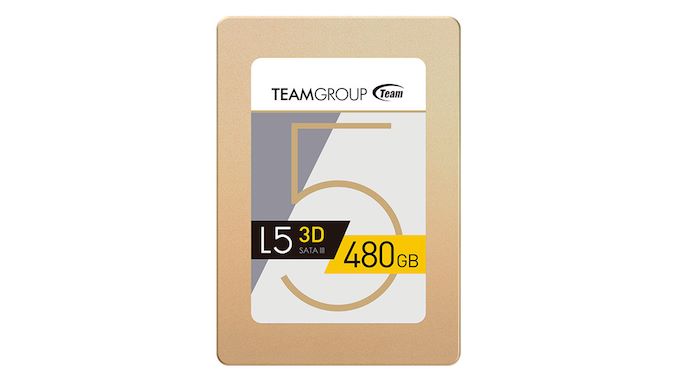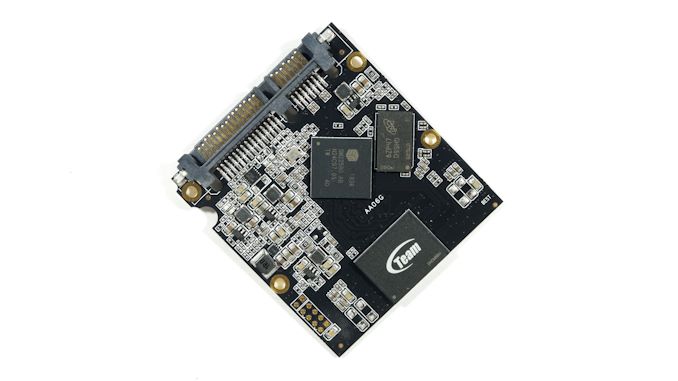The TeamGroup L5 LITE 3D (480GB) SATA SSD Review: Entry-Level Price With Mainstream Performance
by Billy Tallis on September 20, 2019 9:00 AM EST- Posted in
- SSDs
- SATA
- Silicon Motion
- SM2258
- TeamGroup

This year, the SSD market has been rather sedate. After dramatic price crashes in 2018, the market has leveled out and retail SSD prices have been fairly consistent for months. Only a handful of products have launched using the new 9x-layer 3D NAND, and there's been just one major new SSD controller launch so far in 2019. The whole industry is gearing up for the PCIe 4.0 transition, but it's off to a slow start. That gives us the chance to fill in some gaps in our SSD coverage by taking a closer look at several drives that we were unable to review at launch. This is the first in a series of reviews that will look at drives that aren't brand new but are still worth a second look.
First up is the TeamGroup L5 LITE 3D, a SATA drive that was consistently on the leading edge of last year's price drops and remains within a few dollars of the cheapest products currently available. The L5 LITE 3D was one of the first drives to cross some notable price thresholds: less than $20 for 120GB, $30 for 240GB, $50 for 480GB and $100 for 960GB. It's not staying below those levels all the time, but it's also not going more than a few weeks without going on sale. Given the pricing and the "lite" in its name, one could easily assume that it is an entry-level DRAMless product, but it actually uses the more mainstream Silicon Motion SM2258 controller platform with a full-sized DRAM cache. Team has even gone with a nice full metal case instead of using plastic or cheaping out on the connectors as we saw with the Mushkin Source, so the product as a whole doesn't give the impression that it was subjected to rigorous cost-cutting measures.
| TeamGroup L5 LITE 3D SSD Specifications | ||||
| Capacity | 120 GB | 240 GB | 480 GB | 960 GB |
| Controller | Silicon Motion SM2258 | |||
| DRAM Buffer | Yes | |||
| NAND Flash | 3D TLC NAND | |||
| Form-Factor, Interface | 2.5-inch/7-mm, SATA 6 Gbps | |||
| Sequential Read | 470 MB/s | 500 MB/s | ||
| Sequential Write | 300 MB/s | 400 MB/s | 420 MB/s | 480 MB/s |
| 4kB Random Read IOPS | 30k | 65k | 70k | 80k |
| 4kB Random Write IOPS | 40k | 70k | 70k | 70k |
| Warranty | 3 years | |||
| Write Endurance | 30 TB 0.22 DWPD |
60 TB 0.22 DWPD |
120 TB 0.22 DWPD |
240 TB 0.22 DWPD |
| Current Retail Price | $24.99 (21¢/GB) |
$33.99 (14¢/GB) |
$53.99 (11¢/GB) |
$97.99 (10¢/GB) |
It appears that the secret to Team's aggressive pricing on this model boils down to two main factors: a 3-year warranty that's more typical of entry-level drives than mainstream drives, and using whatever memory is cheapest at the moment. We've seen reports of up to four different variants of the L5 LITE 3D in the wild, as distinguished by their firmware version. Given that the L5 LITE 3D's price has dropped by more than 60% since it was introduced, that many revisions isn't as ridiculous as it might seem at first glance. We don't appreciate when mainstream SSDs make major BOM changes without changing the model name, but it's more forgivable for an entry level drive, especially when the SATA bottleneck limits the performance impact that changing NAND can have.
Our 480GB sample reports firmware version Q0410A and based on the serial number it appears to have been manufactured in late October 2018. The DRAM on the drive is Micron DDR3 but the sole NAND package bears Team's logo rather than that of one of the NAND manufacturers. That NAND package also bears the marking "DHCM80A1", but that doesn't shed much light on whose NAND lies beneath. It's possible this drive was built with lower-grade flash memory, but either way we didn't detect any new errors during our testing. The write endurance rating of just over 0.2 DWPD for 3 years is definitely lower than mainstream SATA drives.
For this review, we're primarily focusing on comparing the L5 LITE 3D against other TLC SATA drives of similar capacity. The Mushkin Source is fairly typical of recent DRAMless SATA SSDs and uses the DRAMless variant of the same Silicon Motion controller that Team is using. The Crucial MX500 and SanDisk Ultra 3D are mainstream SATA drives from two of the top tier brands. We've also thrown in results from an entry-level NVMe SSD (MyDigitalSSD SBX), Team's high-end NVMe SSD (MP34), and the Samsung 860 PRO to show the current limits of what a premium SATA SSD can achieve.
| AnandTech 2018 Consumer SSD Testbed | |
| CPU | Intel Xeon E3 1240 v5 |
| Motherboard | ASRock Fatal1ty E3V5 Performance Gaming/OC |
| Chipset | Intel C232 |
| Memory | 4x 8GB G.SKILL Ripjaws DDR4-2400 CL15 |
| Graphics | AMD Radeon HD 5450, 1920x1200@60Hz |
| Software | Windows 10 x64, version 1709 |
| Linux kernel version 4.14, fio version 3.6 | |
| Spectre/Meltdown microcode and OS patches current as of May 2018 | |
- Thanks to Intel for the Xeon E3 1240 v5 CPU
- Thanks to ASRock for the E3V5 Performance Gaming/OC
- Thanks to G.SKILL for the Ripjaws DDR4-2400 RAM
- Thanks to Corsair for the RM750 power supply, Carbide 200R case, and Hydro H60 CPU cooler
- Thanks to Quarch for the HD Programmable Power Module and accessories
- Thanks to StarTech for providing a RK2236BKF 22U rack cabinet.














42 Comments
View All Comments
jabber - Saturday, September 21, 2019 - link
Always be wary of 1 Star tech reviews on Amazon. 60% of them are usually disgruntled "Doesn't work on Mac!" reviews.flyingpants265 - Saturday, September 21, 2019 - link
"They're a biased sample, as very happy and very unhappy people tend to self-report the most. Which doesn't mean what you state is untrue, but it's not something we can corroborate."Ryan, that doesn't explain why one model/brand can have 27% 1-star reviews, and another has 7%.... Unless you think Team Group customers are SEVERAL TIMES MORE outspoken than Crucial/Samsung/whatever customers for some reason. You can't ignore those reports. Ofc the product doesn't have a 27% failure rate, but it's likely much higher than competing products.
Korguz - Saturday, September 21, 2019 - link
ever consider that maybe the bad reviews are either fake, or made up reviews with the person not actually owning, or even bought the product ?flyingpants265 - Monday, September 23, 2019 - link
...Then you'd have to explain why ONLY TEAM GROUP SSDs have tons of fake 1-star reviews, and other SSDs don't. Seems Anandtech commenters are not that bright..Korguz - Sunday, September 29, 2019 - link
maybe one person who bought one, it failed, then to try yo get even, created more then one account ? unless you can PROVE these supposed 1 star reviews are real reviews, then i guess you are not that bright as well... cant really prove your point, so you resort to insults.. grow upKraszmyl - Friday, September 20, 2019 - link
I have nearly a thousand of thier drives from 128g to 480g and so far no failures. Also yes cheap products have poor support, that's one of the reasons why they are cheaper.Samus - Saturday, September 21, 2019 - link
I'd err on the side of caution when dealing with Team Group, though. Failed memory (which I've seen plenty of over the years) is one thing, but failed data storage is a lot more catastrophic. I can't believe I'm saying this but I'd feel safer with an ADATA SSD than a Team Group SSD...and I've seen a number of ADATA's fail, though none recently (in the last few years)bananaforscale - Saturday, September 21, 2019 - link
It's your responsibility to make backups. Never allow a single point of failure.philehidiot - Saturday, September 21, 2019 - link
Aye, especially with SSDs where data recovery is harder than with a HDD. Personally, I pop critical data on two local SSDs and then a memory stick, phone or other system. I don't like the cloud as it is at the mercy of the Internet or another company and I've had access issues which have denied me access to data or, weirdly, only given me access to months old versions. So I prefer a dual local backup, so if a drive fails I can just switch to the backup immediately, and also another copy which is not linked to the same system in case of some catastrophic PSU weirdness that takes out other components (happened once a long time ago and with a cheap PSU) or malware attacks. If I was getting a cheap SSD with a reduced warranty, knowing it uses whatever NAND is cheap at the time, I'd not be using that in a critical system without adequate redundancy (RAID, most likely). You pays your money and takes your choice but if you buy cheap, ensure you're protected... And if you buy expensive.... Ditto.evernessince - Saturday, September 21, 2019 - link
Technically speaking the failure rates should be no higher then other manufacturers, after all they are using the same NAND and controllers as everyone else. That said there is something to be said for poor customer service. I don't know how they are getting that many 1 star reviews though, not unless they are just rebranding B stock.Also, you shouldn't trust only one source for reviews and you should always look at who is posting the bad reviews. For example, this guy seems to be the exact same guy who posted on Newegg as well
https://www.amazon.com/gp/profile/amzn1.account.AF...
He seems to leave a lot of bad reviews and often times does not do a good job explaining why. Judging by their English usage, I'd also say they are not a native speaker. There are plenty of companies in China they also pay people to go out and write both good and bad reviews for competing products which makes research on reviewers all the more important.
I'm not saying they don't deserve their rating, I'm just saying you should always check not just the reviews but the reviewers as well. 2 sources minimum as well. It's a PITA but there are so many fake reviews out there (especially on Amazon) that it's required if you want to get what you paid for.